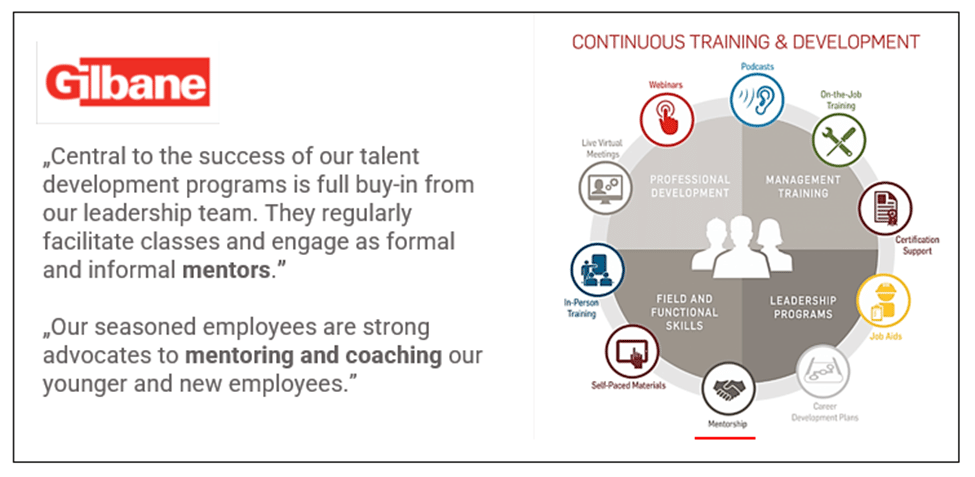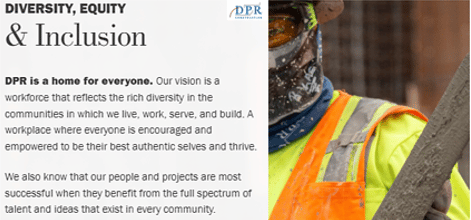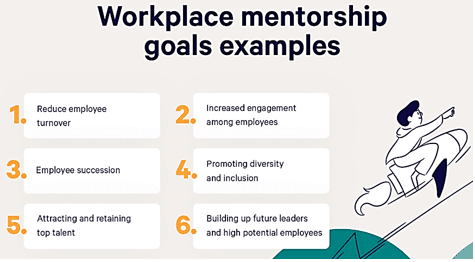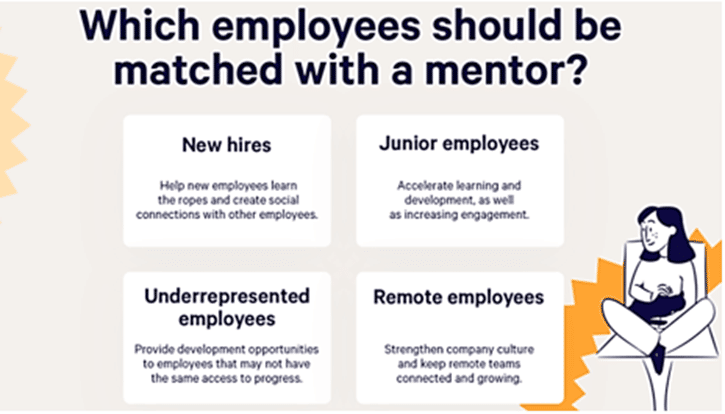Given that the construction industry is struggling with skilled labor shortages and an aging workforce, every construction business owner and manager should consider mentorship.
If they want to attract new talent and keep their existing employees satisfied and motivated, they should look into the best ways to secure the transfer of knowledge and experience within their organization.
That usually involves some form of mentorship.
This article will take a closer look at why mentorship in construction is so important, along with its far-reaching benefits, followed by tips on creating a construction mentorship program.
In this article...
Why Is Mentorship Important in Construction
Before we expand on the importance of mentorship in construction, let’s quickly define what it means.
A mentor is an experienced person who advises and helps another, less experienced one in order to make them more competent at their job.
In construction, where incompetence and inexperience can lead to fatal accidents and/or costly mistakes, different forms of mentorship have long been recognized as a crucial aspect of successful operations and business growth.
Although it comes in different shapes, mentorship in construction usually involves pairing a new employee with an experienced one, so the latter can offer guidance and share advice with the newcomer.
However, this benefits not only the mentee, but also the mentor, the company that employs them, and the construction industry at large.
The advantages of mentorship in construction are vast and diverse, but these four are of special importance.
Attracts New Talent to Construction
It’s simple—if you want to attract new talented and motivated employees to construction, nowadays it will take more than offering a good salary and benefits package.
Thus, highlighting your company’s mentorship program when recruiting new talent can be a decisive factor in attracting and hiring a new generation of construction professionals.
A mentorship program indicates that your company is eager to provide new employees with everything they need to navigate their new job and long-term career, i.e., a supportive environment with clear opportunities to learn and grow as professionals.
This is particularly important as younger generations tend to have a different approach to career development than their more seasoned counterparts, where the salary and benefits, albeit important, are not the only factors when deciding who to work for.
Consequently, some companies have ingrained mentorship in their organization, like Gilbane, which uses its training and development programs to attract new talent to the construction industry.

Gilbane is a great example of a construction company that, in addition to offering one of the most comprehensive benefits packages, focuses on the lifelong learning and development of its employees.
Naturally, it also uses this as a competitive advantage when recruiting new talent.
So, mentorship will not only enable the transfer of knowledge and experience between old and new workers, but it will also, when properly established and advertised, help attract a wider pool of new talent to your company.
Promotes Inclusion in Construction
So, how can a mentorship program help promote inclusion in construction?
New employees, when mentored by the right people, will have a much easier time understanding the ins and outs of their job, as well as the workplace culture they found themselves in.
This will relieve much of the stress and give them a sense of belonging, which is particularly important when a new employee comes from one or more groups typically underrepresented in the construction industry, such as women and minorities.
In turn, that will raise the chances they will stay in your company, making your workforce more diverse and inclusive, thus promoting future recruitment of talent that would probably not consider working in construction.
Furthermore, diversity brings forth learning opportunities and can lead to higher productivity and increased earnings, as discussed in an article by McKinsey.
Many companies, like DPR Construction, realized the importance of promoting inclusion and diversity to advance their company culture and reap all these benefits.

When such statements are backed up by appropriate company policies and dedicated company leadership, it breaks down misconceptions about the construction industry and appeals to younger individuals who would otherwise stay away from construction.
Thus, a mentorship program can empower new employees, including members of groups underrepresented in construction, by giving them the support they need to find their place in your company and the industry in general.
Improves Worker Engagement
When workers are mentored by one or more persons they can turn to for advice and guidance from the start, they will better understand the job expectations and be encouraged to build strong relationships with their colleagues and mentors, including managers.
Clear expectations and close working relationships will foster their sense of purpose and belonging, thus enhancing their engagement level.
Naturally, improved worker engagement will contribute to a positive working environment, which is essential for worker motivation and satisfaction and, consequently, for overall productivity.
Therefore, a properly established mentorship program can act as the foundation on which an employee’s relationship with their job, coworkers, and managers is built, helping create engaged, productive, and motivated employees.
Helps Companies Retain Construction Workers
Finally, having a mentorship program can help construction companies retain their workers.
The reason for greater retention of mentored employees is similar to reasons why mentorship programs help attract new talent and improve worker engagement—they provide support and guidance to construction workers and address their need to develop as professionals.
For instance, a case study done at Randstad, a recruitment company, showed that employees who participated in mentorship programs were 49% less likely to leave the company.
You can read more about how to improve employee retention in the Forbes article shown below:

The important thing to remember is that workers often leave due to poor management and leadership or a lack of career development opportunities.
Mentorship programs can alleviate both of these issues by showing workers that management cares about their professional and personal well-being and giving them opportunities to discuss how they can learn, grow, and improve their skills and career without the need to leave your company.
How to Create a Construction Mentorship Program
Now that we’ve covered some of the major benefits of having a construction mentorship program, let’s see how you can create one.
Of course, the model and format of your mentorship program(s) will depend on your company’s specific needs and goals, including selecting the right mentors to be paired with mentees and performing regular evaluations of the program.
So, here’s how to create a construction mentorship program in five steps.
Define Mentorship Program Goals
As with most tasks, the first step should be to define what are the goals of your mentorship program and how they will be used to measure the program’s success.
Usually, a construction company will strive to achieve more than one goal, but it’s still helpful to identify and rank them, along with setting relevant key performance indicators (KPIs) for measuring their achievement.
For instance, the mentoring program’s primary goal can be onboarding and training new employees.
However, existing workers might also need mentorship, especially when dealing with new technology or securing the transfer of specific skills and know-how before a worker retires.
So, these and other issues concerning the internal transfer of knowledge between existing employees also need to be considered when creating a mentorship program.
Naturally, program goals can include the achievement of all the benefits we mentioned, as shown in these mentorship goals examples, courtesy of Together:

Once the goals are defined, you and your team need to decide how they will be measured (KPI).
For example, promoting workplace diversity and inclusion can be measured by the rate of hiring, promoting, and retaining employees coming from diverse backgrounds.
Similar KPIs can be set for the other defined goals; in any case, the goals of your mentorship program should be documented, and team members should be held accountable for their implementation, progress monitoring, and evaluation.
Choose the Right Mentorship Model
The next step is to choose a suitable mentorship model, which will depend on the goals of your mentoring program, available time and resources, and the number of program participants.
When it comes to different mentoring models, we’ll describe the main types and when they might be used.
We’ll start with the most common type, which is 1-on-1 mentorship.
This is where an experienced worker is paired with a less experienced one to provide support, guidance, and advice that will enable the mentee to develop specific skills and know-how.
Although such mentorship usually involves senior employees mentoring junior employees, sometimes these roles are reversed to achieve specific goals, thus creating reverse mentorship.
You can learn more about it in an article by Experteer.

The reverse mentoring model is particularly useful when senior employees need mentoring to, for example, use new technologies and digital media effectively, or stay updated on the current inclusion and diversity trends.
Another model is group mentorship, where one or more mentors work with a group of employees.
The group model is popular for different reasons (e.g., time and cost efficiency), but its main advantage is that it provides mentees with a greater sense of support and camaraderie with other participants, thus creating stronger working relationships in the future.
Subtypes of this model include peer mentoring, where two workers of a similar level of experience are paired to share their knowledge, best practices, and practical tips.
In conclusion, different factors will influence your decision on what the right mentorship model is, but any selected model(s) should ensure that the program goals are achieved efficiently.
Select the Right Mentors
Of course, for the mentorship program to work, you need mentors who have the skills and experience required for the mentorship program in conjunction with having the right attitude and motivation to be mentors.
So, according to the goals of its mentorship program, a construction company should first identify staff members with the relevant skills and experience in specific areas.
After that, it should determine the level of their interest and motivation to become mentors.
When doing so, it pays to remind potential mentors of the benefits they can expect when mentoring, such as honing their leadership, coaching, and communication skills and coming in contact with new generations’ perspectives.
Here are some of these benefits that can help you attract the right mentors within your organization:

Of course, a potential mentor might have the right skills to take on that role, but the selection will also depend on their personality traits and attitude towards mentorship.
But, choosing the right mentors also involves careful pairing with the right mentees.
Pair Mentors With the Right Mentees
As previously stated, mentors should be paired with those mentees that would benefit most from that mentor’s skills and experience.
Moreover, mentors and mentees should be paired in a way that enables them to achieve the set goals of mentorship productively, meaning that attention should also be given to matching persons with similar personalities and communication styles.
As for which employees should be paired with a mentor, here are a few examples:

For instance, new hires usually need to be mentored to navigate their new workplace, and junior employees to accelerate their learning and development or increase their engagement.
Mentoring can also provide underrepresented groups with equal access to career development opportunities or be used to strengthen the company culture among remote employees.
In summary, when pairing mentors with the right mentees, one should consider the mentor’s skills and experience, personality, and communication style and match them with the mentee that would benefit most from that mentor.
Perform Regular Evaluations
Of course, no mentorship program can be implemented without performing regular evaluations to measure its success.
The first level of evaluation occurs while the mentorship program is underway and refers to tracking the progress of individual pairs/groups of mentors and mentees by asking all involved participants for regular feedback.
When dealing with 1-on-1 mentorship, this will be the mentor and the mentee, whereas group mentorship can involve getting feedback from one or more mentors and multiple mentees.
In any case, feedback should be given regularly, e.g., every two weeks, once a month, or any other period, depending on the planned duration of mentorship.
It can be obtained by separately interviewing the mentor and the mentee, holding a group discussion with the mentees and/or mentors involved, or sending an anonymous survey to all participants.
Naturally, the market offers specialized mentoring software solutions that can make mentorship in your company significantly easier and more efficient, like Together.

Whether with the help of mentoring software or not, the second level of evaluation occurs when the program reaches a predefined milestone or runs its course.
Either way, this evaluation will consider the program as a whole, look at the goals (KPIs) set for the program, and use different methods to quantify the success of the mentorship program.
Keep in mind that some KPIs will be easy to measure, such as the number of employees participating in the program as mentees or mentors or the employee retention rate before and after implementing the program.
However, other KPIs may be less quantifiable and depend on more subjective means of evaluation, such as self-assessment.
In summary, regular evaluations are performed to measure the achievement of the program goals and, whether done during or after mentoring, provide insight into what should be improved to better achieve those goals.
Conclusion
So, we’ve covered a few reasons why mentorship in construction is an essential element of successful operations and business growth: it secures the transfer of knowledge and experience, helps attract new talent, and also improves worker engagement.
In the hope that those reasons might convince you to start a mentorship program, we listed five steps on how to create it.
We hope that this article will prove a valuable source of information on getting started with your own mentorship program.





